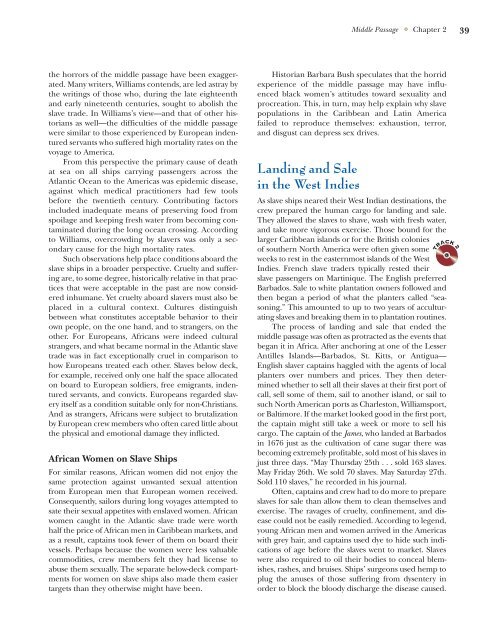Create successful ePaper yourself
Turn your PDF publications into a flip-book with our unique Google optimized e-Paper software.
the horrors of the middle passage have been exaggerated.<br />
Many writers, Williams contends, are led astray by<br />
the writings of those who, during the late eighteenth<br />
and early nineteenth centuries, sought to abolish the<br />
slave trade. In Williams’s view—and that of other historians<br />
as well—the difficulties of the middle passage<br />
were similar to those experienced by European indentured<br />
servants who suffered high mortality rates on the<br />
voyage to America.<br />
From this perspective the primary cause of death<br />
at sea on all ships carrying passengers across the<br />
Atlantic Ocean to the Americas was epidemic disease,<br />
against which medical practitioners had few tools<br />
before the twentieth century. Contributing factors<br />
included inadequate means of preserving food from<br />
spoilage and keeping fresh water from becoming contaminated<br />
during the long ocean crossing. According<br />
to Williams, overcrowding by slavers was only a secondary<br />
cause for the high mortality rates.<br />
Such observations help place conditions aboard the<br />
slave ships in a broader perspective. Cruelty and suffering<br />
are, to some degree, historically relative in that practices<br />
that were acceptable in the past are now considered<br />
inhumane. Yet cruelty aboard slavers must also be<br />
placed in a cultural context. Cultures distinguish<br />
between what constitutes acceptable behavior to their<br />
own people, on the one hand, and to strangers, on the<br />
other. For Europeans, Africans were indeed cultural<br />
strangers, and what became normal in the Atlantic slave<br />
trade was in fact exceptionally cruel in comparison to<br />
how Europeans treated each other. Slaves below deck,<br />
for example, received only one half the space allocated<br />
on board to European soldiers, free emigrants, indentured<br />
servants, and convicts. Europeans regarded slavery<br />
itself as a condition suitable only for non-Christians.<br />
And as strangers, Africans were subject to brutalization<br />
by European crew members who often cared little about<br />
the physical and emotional damage they inflicted.<br />
African Women on Slave Ships<br />
For similar reasons, African women did not enjoy the<br />
same protection against unwanted sexual attention<br />
from European men that European women received.<br />
Consequently, sailors during long voyages attempted to<br />
sate their sexual appetites with enslaved women. African<br />
women caught in the Atlantic slave trade were worth<br />
half the price of African men in Caribbean markets, and<br />
as a result, captains took fewer of them on board their<br />
vessels. Perhaps because the women were less valuable<br />
commodities, crew members felt they had license to<br />
abuse them sexually. The separate below-deck compartments<br />
for women on slave ships also made them easier<br />
targets than they otherwise might have been.<br />
Historian Barbara Bush speculates that the horrid<br />
experience of the middle passage may have influenced<br />
black women’s attitudes toward sexuality and<br />
procreation. This, in turn, may help explain why slave<br />
populations in the Caribbean and Latin America<br />
failed to reproduce themselves: exhaustion, terror,<br />
and disgust can depress sex drives.<br />
Landing and Sale<br />
in the West Indies<br />
<strong>Middle</strong> <strong>Passage</strong> Chapter 2<br />
As slave ships neared their West Indian destinations, the<br />
crew prepared the human cargo for landing and sale.<br />
They allowed the slaves to shave, wash with fresh water,<br />
and take more vigorous exercise. Those bound for the<br />
larger Caribbean islands or for the British colonies<br />
of southern North America were often given some<br />
weeks to rest in the easternmost islands of the West<br />
Indies. French slave traders typically rested their<br />
slave passengers on Martinique. The English preferred<br />
Barbados. Sale to white plantation owners followed and<br />
then began a period of what the planters called “seasoning.”<br />
This amounted to up to two years of acculturating<br />
slaves and breaking them in to plantation routines.<br />
The process of landing and sale that ended the<br />
middle passage was often as protracted as the events that<br />
began it in Africa. After anchoring at one of the Lesser<br />
Antilles Islands—Barbados, St. Kitts, or Antigua—<br />
English slaver captains haggled with the agents of local<br />
planters over numbers and prices. They then determined<br />
whether to sell all their slaves at their first port of<br />
call, sell some of them, sail to another island, or sail to<br />
such North American ports as Charleston, Williamsport,<br />
or Baltimore. If the market looked good in the first port,<br />
the captain might still take a week or more to sell his<br />
cargo. The captain of the James, who landed at Barbados<br />
in 1676 just as the cultivation of cane sugar there was<br />
becoming extremely profitable, sold most of his slaves in<br />
just three days. “May Thursday 25th . . . sold 163 slaves.<br />
May Friday 26th. We sold 70 slaves. May Saturday 27th.<br />
Sold 110 slaves,” he recorded in his journal.<br />
Often, captains and crew had to do more to prepare<br />
slaves for sale than allow them to clean themselves and<br />
exercise. The ravages of cruelty, confinement, and disease<br />
could not be easily remedied. According to legend,<br />
young African men and women arrived in the Americas<br />
with grey hair, and captains used dye to hide such indications<br />
of age before the slaves went to market. Slaves<br />
were also required to oil their bodies to conceal blemishes,<br />
rashes, and bruises. Ships’ surgeons used hemp to<br />
plug the anuses of those suffering from dysentery in<br />
order to block the bloody discharge the disease caused.<br />
TRACK 2<br />
39

















